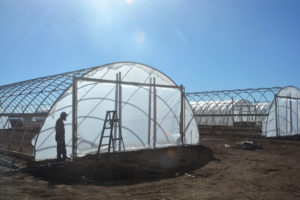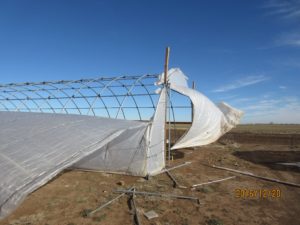Fortified ‘high tunnel’ growing structures withstand ‘bomb cyclone’ winds
AgriLife Research offers tips via fact sheet, videos
Writer: Kay Ledbetter, 806-677-5608, [email protected]
Contact: Dr. Charlie Rush, 806-354-5804, [email protected]

AMARILLO – Lessons learned in construction of protected agriculture systems, or high tunnels, kept Texas A&M AgriLife Research tunnels near Amarillo securely in place during the recent “bomb cyclone” that reached recorded wind gusts of 80-90 mph.

Dr. Charlie Rush, AgriLife Research plant pathologist in Amarillo, has spent the past four years building high tunnels and researching their use in growing vegetables at the Bushland research station.
After a number of early setbacks, he and his crew developed some steps to fortify the structures to withstand the high winds that often occur in the Texas Panhandle.
The methods they developed have been captured in an educational fact sheet and a series of “walk-and-talk” construction videos available at https://tinyurl.com/HighPlainsVegetableProgram.
High tunnels, often referred to as hoop houses, are plastic covered, passively heated, walk-in, semi-permanent structures. They not only provide season extension, but also offer growers more control over extreme environmental conditions.
“It’s important that if the vegetable industry is going to grow up here, and we are going to use high tunnels, we have to figure out how to keep them from blowing away,” Rush said.
He explained the high-water requirements for maximum yields and the declining Ogallala Aquifer water table limit the sustainability of traditional crop production in the High Plains.

“That’s why we began working with producers who are considering the feasibility of producing alternate crops, such as high-value vegetables, that could be produced on less acreage with less total water but still potentially provide significant income,” Rush said.
To accomplish this, he said, growers need to take advantage of advances in vegetable production techniques, such as protected agricultural systems or high tunnels. High tunnels can extend the growing season, maximize yield and quality, and optimize water-use efficiency.
Rush said in 2015 he initiated a research program to evaluate the feasibility of high-value vegetable production in the Texas Panhandle. Part of that process was the purchase of four high tunnels, which were built according to manufacturer’s instructions.

But, Rush said, it became very clear that vegetable production under high tunnels in the Texas Panhandle had a unique challenge with the extremely high winds common to the area.
“It quickly became obvious that the high winds in the region posed an immediate threat to successful vegetable production within them,” he said. “Within weeks after completion of our first high tunnel, severe straight-line winds nearly blew one completely out of the ground, and within a few months, the reinforced plastic covering had been totally blown off two others.”
Through trial and error, Rush said the research team identified techniques that helped secure the high tunnels, and they have now survived continuous winds of 60 mph and gusts near 90 mph.
“This fact sheet provides information that should help farmers in windy environments build high tunnels that have improved chances of surviving the harsh Panhandle winds,” he said.


